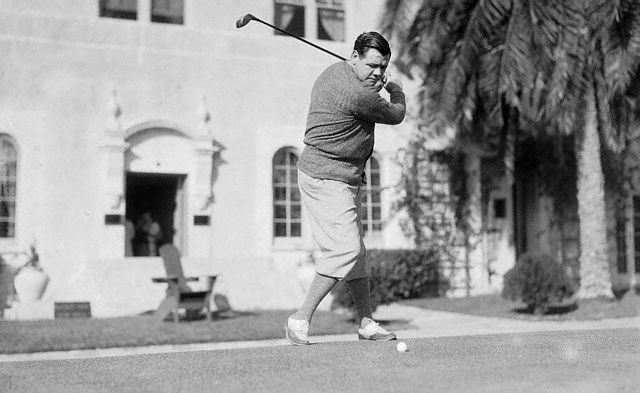Before Farragut Hall housed cadets, the building housed hotel guests from around the world including Babe Ruth and Al Capone

Babe Ruth and his daughter Julia outside of what is now Farragut Hall, February 11, 1931
St. Pete hotels swear Babe Ruth and Al Capone were once guests. We settle the legends.
Locals say the Bambino and Scarface both vacationed in sleepy St. Petersburg during the 20s and 30s. But where did they actually stay? (original article was posted in Tampa Bay Times on May 7, 2019, and written by Gabrielle Calise)
The 1925 Jungle Country Club Hotel is significant for its association with the development of tourism in St. Petersburg during the 1920s. Built during the city’s golden era of hotels, the hotel reflects the changing character of the city’s lodging industry from small boarding homes such as those built in the 1910s to the larger sized hotels built during the Florida Land Boom Era. One of ten large hotels built in St. Petersburg during the Florida Boom Era, the Jungle Country Club Hotel was unique in that it was the first of three hotels constructed on the western portion of the Pinellas Peninsula. This setting allowed the hotel to offer a variety of recreational activities that were not readily available at downtown hotels.
In 1923, Fuller purchased his father’s interests in the Allen Fuller Corporation, which was founded in 1919, and began extensive development in the Jungle Area on the shores of Boca Ciega Bay. Fuller’s developments include the Jungle Country Club Hotel, the Jungle Prado, several downtown structures and a multitude of residential lots throughout the city.
The hotel was designed by New York architect Henry Taylor in the Mediterranean Revival style of architecture. Taylor also designed the Vinoy Park Hotel, St. Mary’s Church, the Florida Theater (now demolished), and the Jungle Prado. The two- and three-story structure forms a rectangular block around a central courtyard. Two canted wings project from the west facade, opening like arms to Boca Ciega Bay. These wings, three stories in height, spring from asymmetrical towers, the north tower being most prominent. The building was constructed of steel and hollow clay tile with the exterior walls finished in a textured stucco. The roof is covered with a multi-chromatic random mixture of red, brown and beige barrel clay roofing tiles. Fountains glistened in a central courtyard, tiled in terracotta. The first and second floors boasted ornate, wood-trimmed open lounges. French doors prevailed throughout the hotel. The main entrance to the hotel faced south onto 5th Avenue and is identified through a two-story sopraporta, which features classical detailing capped by four urns.

Babe Ruth swings a golf club outside of what is now Farragut Hall, February 11, 1931
The Jungle Club Hotel housed many wealthy, northern tourists, boasting names like Babe Ruth, Jimmy Walker, and Jack Dempsey, as well as several quiet men who ran Al Capone’s gambling ship off the gulf. When World War II, many of the hotels in St. Petersburg saw a sharp decrease in tourism. To supplement the lack of tourism, most of the large hotels leased themselves out to the U.S. Army Air Corps. The Jungle Country Club was no exception, and in 1942 the building began housing Air Corps trainees.
In 1944, a $300,000 agreement was signed ensuring the transfer of the luxurious Jungle Club Hotel to Admiral Farragut Academy. Farragut adaptively reused the hotel building and began the design of a campus plan which included the construction of numerous administration and classroom buildings as well as the addition of recreational facilities. In the late 1940s and early 1950s, the Academy sold portions of the original golf course site which was subsequently developed with single-family homes. On November 5, 1992, the City Council of the City of St. Petersburg, Florida passed a resolution designating the building, now called Farragut Hall, as a local historic landmark.
View more historical photos of the Jungle Country Club Hotel





